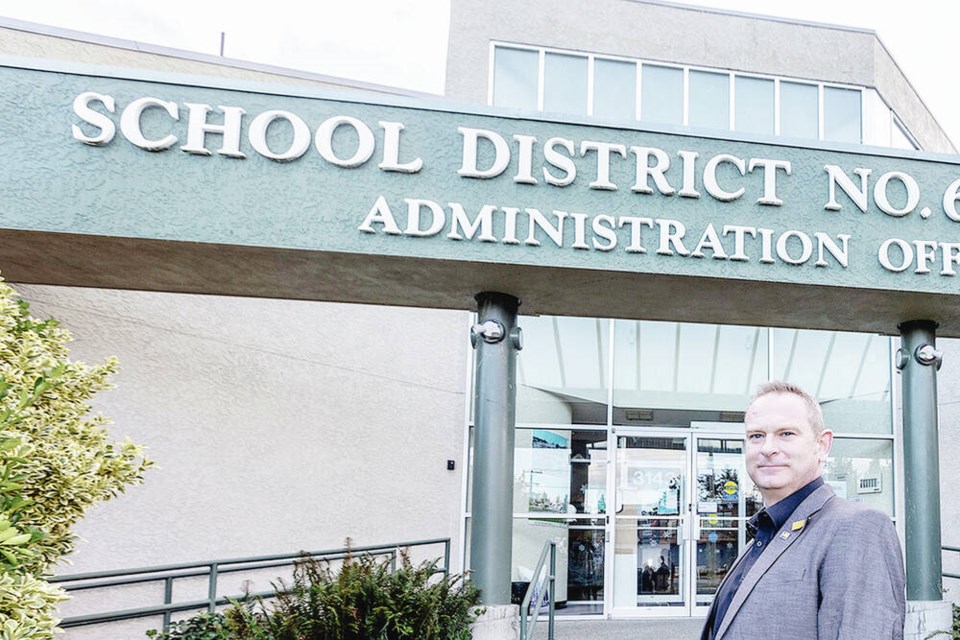Paul Block is bringing more than a little local knowledge to his new role as superintendent of the Sooke School District, which starts on Jan. 1.
The 54-year-old has been in the district since 1992, the year of the Barcelona Olympics and Bill Clinton’s first presidential-election win.
Back then, he was freshly graduated as a teacher from the University of Victoria, but teaching jobs were hard to come by.
He started in the district as an education assistant at Saseenos Elementary, working with individual students needing support, followed by summer work with the facilities department stripping gym floors, moving furniture and “whatever they needed me for.”
“I didn’t have my first opportunity to be a classroom teacher until ‘93.”
That came at Dunsmuir Middle School.
The prospect of someday getting the district’s top job hadn’t come close to crossing his mind back then.
“That wasn’t on my radar at all,” Block said.
But over time he went on to earn a master’s degree from Gonzaga University in Washington state, and moved into duties as a vice-principal, principal, district principal and deputy superintendent.
There was a national search for a successor to outgoing superintendent Scott Stinson, who announced his retirement in April, and Block emerged from the crowd.
Not bad for someone who during his first handful of years as a teacher was still very active in local bands and had an interest in film, and wasn’t sure how far that would go.
“I was thinking I could be rock star, as well, or at least making a living in the arts, but that never panned out.”
Block had made his way to Victoria from the Lower Mainland in 1987, stayed for university and never left. He is married and has two children who went from kindergarten to Grade 12 in the district, so the connections are are also strong at home.
The role he inherits from Stinson puts him in charge of one the fastest-growing of the 60 school districts across B.C., which wasn’t quite the place he came to in the early ’90s.
“When I first came to the district, I think what attracted me to it was the family feel,” he said. “It was very small.”
Block said that aspect has gone away to some extent “in the chaos of growth,” but he would like it to become more a part of the district’s identity in his time at the helm.
During his long stint as a teacher, Block had a few particular students who would also move on to prominent district roles.
He said he is proud to say he taught both former school board chair and now Langford-Juan de Fuca MLA Ravi Parmar and current board chair Amanda Dowhy.
“And now it’s come full circle,” Block said.
With 2023 on the horizon, the district is now up to more than 13,700 students in 30 schools — and an all-time high of 59 portables. The district expects to have more than 16,000 students by 2030.
The biggest year-to-year jump in enrolment of late was in 2021, when 827 new students arrived.
The growth has meant that several new schools have been built in recent years, and more are on the way. But even when another school is just around the corner, it doesn’t seem to come soon enough these days, Block said.
Still, he said the Ministry of Education has worked hard to meet the district’s needs. There have been 2,660 student spaces added over the past five years with $260 million in provincial funding.
Block said that the district’s growth won’t be letting up anytime soon, and even if things were to slow down with the building activity in Langford that has fuelled much of increase in student numbers, Colwood and Sooke “are certainly picking up the pace.”
“We see growth consistently for the next 15 years in our long-range projections.”
With that in mind, Block said 2024 will bring work on a new strategic plan that “will reset the table on how we’re going to manage growth.”
Whatever comes out of that, growth clearly presents a unique challenge for the district, Block said.
“It creates challenges for us in terms of finding seats and always being worried about that,” he said. “But it’s also creating inequities across our district. We have schools that are literally 50-plus years old and then we have brand-new ones, so we have communities that are looking to us to create equity in terms of what’s to be offered in those buildings.
“It’s a whole new driver that other districts don’t have to deal with.”
Despite that, the situation is well-in-hand because he can “stand on the shoulders” of previous superintendents like Stinson and Jim Cambridge, Block said.
He said that leading the district means dealing with a wider scope of communities than some people realize, since not everyone knows it takes in Langford, Colwood, Metchosin, Sooke, the Highlands and Port Renfrew.
“A lot of people think it’s Langford, and we have to cover a lot more ground than that.”
He said the district also includes the traditional territories of the T’Sou-ke, Sc’ianew and Pacheedaht nations. Some schools are in the traditional territory of Esquimalt Nation and Songhees Nation, as well.
Acknowledging them by gifting Indigenous names to new schools has become important to the district, Block said.
“The naming of schools is a true act of truth and reconciliation,” he said. “We are thrilled to continue to do that great work. It’s a small step toward the work that we have to do.”



